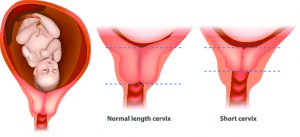Women with a short cervix have about a 50% chance of premature delivery.
The cervix is the cylindrical-shaped opening to the uterus that is located just above the vagina. Normally, the cervix lengthens to about 30 to 50 millimeters (mm) during pregnancy. A cervix is considered short if it has a length that is shorter than this length, but expected cervical length also depends on gestational age. At about 18 to 24 weeks pf pregnancy, a cervical length less than 25 mm is considered short. However, as pregnancy progresses, cervical length normally decreases, as we explain here, so your physician will take into account how far along you are when evaluating a short cervix.
A short cervix is important to note, because it is linked with a higher risk of preterm birth. A birth is considered preterm if it occurs prior to 37 weeks of gestation. Preterm births can be a cause of substantial morbidity for newborns, so should be prevented when possible. As shown in one study, among women who were 22 to 24 weeks pregnant, fewer than 2% had a cervical length of less than 15 mm; despite this low incidence of short cervix, these cases accounted for more than half of preterm births occurring before 32 weeks. Thus, short cervix is one major cause of premature births. The shorter the cervical length, the higher the likelihood of preterm birth, especially among women who have had a preterm delivery before.
While a majority of women are not routinely screened for a short cervix during regular prenatal visits, physicians may note cervical length during the routine anatomy ultrasound that occurs around 18 to 22 weeks of pregnancy. However, transabdominal ultrasound is not a fully reliable tool for diagnosing short cervix and may overestimate cervical length. Transvaginal ultrasound is generally performed when a short cervix is suspected. Certain signals may alert physicians to investigate a woman for a short cervix. These include signs of preterm labor, such as frequent contractions, spotting, pelvic pressure, or a dull ache in the lower back. Another reason for physicians to follow a woman for risk of preterm birth is if she experienced a premature delivery during a previous pregnancy. If cervical length is short based on a transvaginal ultrasound, a woman may be monitored for preterm labor symptoms and potential intra-amniotic infection.
Women with a short cervix have about a 50% chance of premature delivery. Potential treatments to prolong pregnancy include cerclage, or stitching the cervix closed, or use of vaginal progesterone. Both of these have shown benefit in some groups of women with short cervix. A cervical pessary is a newer device designed to hold the cervix closed. Bed rest alone has not been proven to reduce risk of premature delivery among women with a short cervix.
Women who are concerned about a short cervix or about risk of premature delivery, and pregnant women who have previously experienced a short cervix or preterm birth, should consult with their physicians as early as possible during pregnancy.

